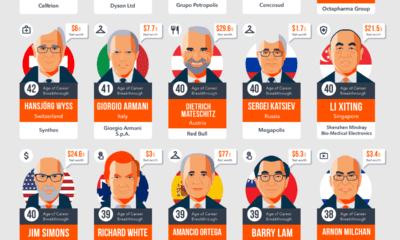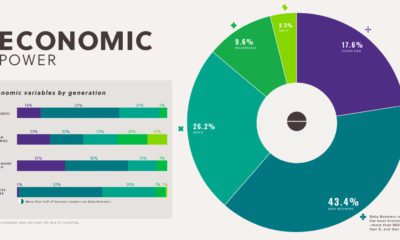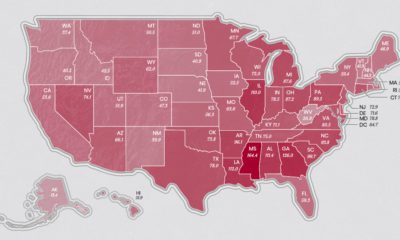Platforms like Kickstarter or IndieGoGo have allowed aspiring entrepreneurs to get their ideas in front of millions, while generating invaluable amounts of buzz and publicity. Highly successful campaigns include products or proposals such as Ethereum, Oculus Rift, Pebble, or Star Citizen, which have combined to raise hundreds of millions of dollars in new capital. However, because crowdfunding is open to everyone, not every campaign brings home the bacon. In reality, some campaigns are just plain strange or border on being nonsensical in nature. Other ideas just bomb spectacularly. Either the concept has no product-market fit, or the prototype simply doesn’t do what it is supposed to do.
Weird Crowdfunding Fails
Today’s infographic comes from SSLs, highlighting 19 crowdfunding campaigns that were not destined to change the world in any meaningful capacity. Note: These are all reward-based crowdfunding campaigns. Along the right-hand side of the infographic, it shows the platform used, amount raised, and the fundraising goal. Down the middle, it highlights the most ridiculous reward that was offered to backers, and how many people claimed the reward.
Where did some of these projects fall short? What can we learn from them? Some projects such as the Induratus nuclear bunker were destined for failure because they were inherently selfish. The product could have been great, but if it doesn’t benefit the backers, it’s not going to take off. Sadly, the Induratus raised just $1, and as a result the project’s creator is now left very vulnerable to nuclear attacks. The Triton, a set of artificial gills that could allow a user to breathe underwater, had the opposite problem. While the creators behind the project got the hundreds of thousands of dollars of funding they needed, the idea turned out to be scientifically impossible. In fact, the development of similar technology has eluded the world’s top scientists and military contractors for years. The group behind the product was forced to refund backers to the tune of $900,000. Other projects were scientifically viable, while also solving a perceived market need. However, the problem with these products were that they did not serve a large enough market to make sense. The Sauceman’s Satchel is a good example of this. While the creator loved the idea of a “convenient, carry-able, flyable, sauce transport” for camping and travel needs, the market overwhelmingly did not. That’s why it only raised about 40% of its funding goal from 105 backers. Now, the Sauceman Satchel is only serving sauce-lovers in product pitch heaven.
on But fast forward to the end of last week, and SVB was shuttered by regulators after a panic-induced bank run. So, how exactly did this happen? We dig in below.
Road to a Bank Run
SVB and its customers generally thrived during the low interest rate era, but as rates rose, SVB found itself more exposed to risk than a typical bank. Even so, at the end of 2022, the bank’s balance sheet showed no cause for alarm.
As well, the bank was viewed positively in a number of places. Most Wall Street analyst ratings were overwhelmingly positive on the bank’s stock, and Forbes had just added the bank to its Financial All-Stars list. Outward signs of trouble emerged on Wednesday, March 8th, when SVB surprised investors with news that the bank needed to raise more than $2 billion to shore up its balance sheet. The reaction from prominent venture capitalists was not positive, with Coatue Management, Union Square Ventures, and Peter Thiel’s Founders Fund moving to limit exposure to the 40-year-old bank. The influence of these firms is believed to have added fuel to the fire, and a bank run ensued. Also influencing decision making was the fact that SVB had the highest percentage of uninsured domestic deposits of all big banks. These totaled nearly $152 billion, or about 97% of all deposits. By the end of the day, customers had tried to withdraw $42 billion in deposits.
What Triggered the SVB Collapse?
While the collapse of SVB took place over the course of 44 hours, its roots trace back to the early pandemic years. In 2021, U.S. venture capital-backed companies raised a record $330 billion—double the amount seen in 2020. At the time, interest rates were at rock-bottom levels to help buoy the economy. Matt Levine sums up the situation well: “When interest rates are low everywhere, a dollar in 20 years is about as good as a dollar today, so a startup whose business model is “we will lose money for a decade building artificial intelligence, and then rake in lots of money in the far future” sounds pretty good. When interest rates are higher, a dollar today is better than a dollar tomorrow, so investors want cash flows. When interest rates were low for a long time, and suddenly become high, all the money that was rushing to your customers is suddenly cut off.” Source: Pitchbook Why is this important? During this time, SVB received billions of dollars from these venture-backed clients. In one year alone, their deposits increased 100%. They took these funds and invested them in longer-term bonds. As a result, this created a dangerous trap as the company expected rates would remain low. During this time, SVB invested in bonds at the top of the market. As interest rates rose higher and bond prices declined, SVB started taking major losses on their long-term bond holdings.
Losses Fueling a Liquidity Crunch
When SVB reported its fourth quarter results in early 2023, Moody’s Investor Service, a credit rating agency took notice. In early March, it said that SVB was at high risk for a downgrade due to its significant unrealized losses. In response, SVB looked to sell $2 billion of its investments at a loss to help boost liquidity for its struggling balance sheet. Soon, more hedge funds and venture investors realized SVB could be on thin ice. Depositors withdrew funds in droves, spurring a liquidity squeeze and prompting California regulators and the FDIC to step in and shut down the bank.
What Happens Now?
While much of SVB’s activity was focused on the tech sector, the bank’s shocking collapse has rattled a financial sector that is already on edge.
The four biggest U.S. banks lost a combined $52 billion the day before the SVB collapse. On Friday, other banking stocks saw double-digit drops, including Signature Bank (-23%), First Republic (-15%), and Silvergate Capital (-11%).
Source: Morningstar Direct. *Represents March 9 data, trading halted on March 10.
When the dust settles, it’s hard to predict the ripple effects that will emerge from this dramatic event. For investors, the Secretary of the Treasury Janet Yellen announced confidence in the banking system remaining resilient, noting that regulators have the proper tools in response to the issue.
But others have seen trouble brewing as far back as 2020 (or earlier) when commercial banking assets were skyrocketing and banks were buying bonds when rates were low.

















